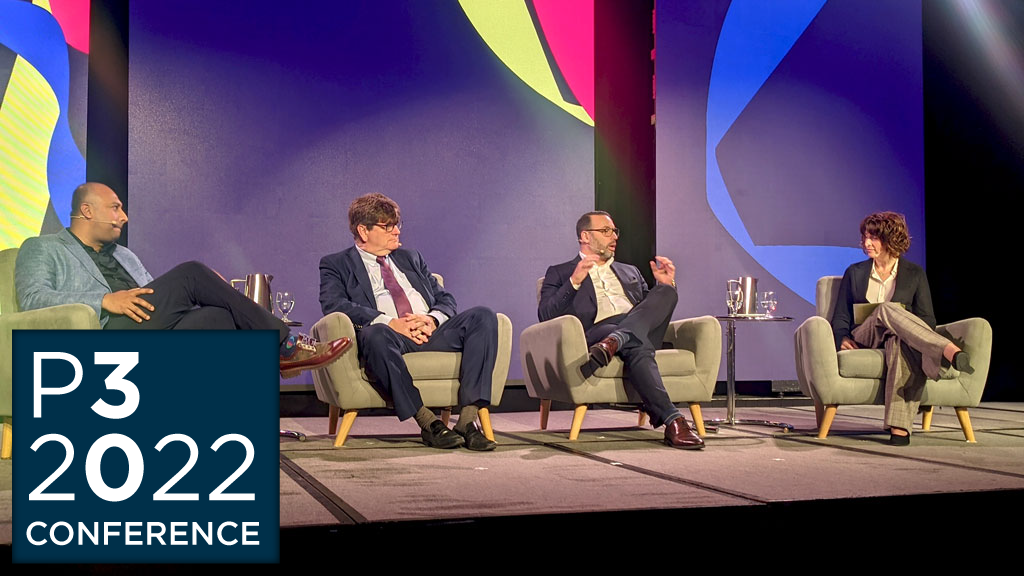Two main barriers to innovation in the design and construction space are resistance to change and the appetite for risk and they go hand in hand, said Ari Bose, director and U.S. Buildings Lead with Arcadis IBI Group.
“Both of these things come down to leadership,” said Bose. “We have to take the responsibility to really allow our people to fail. Once you take that fear of failure out…I think the results can be pretty drastic in most organizations and allow everybody a voice at the table. Sometimes not the senior most person is going to have the best idea.”
Nothing bothers him more than somebody saying “this is how we’ve always done it and this is how we should do it,” he told the crowd at a session billed Green Innovation: How the Private Sector is Breaking Down Barriers to Innovation and Executing Better Projects.
The session was part of the 30th annual P3 conference hosted by the Canadian Council for Public-Private Partnerships.
Ian Kirouac, executive vice-president, Canadian building operations with Pomerleau, said predictability is one of the main barriers to innovation.
“Most of the construction trades or general contractors have less than six months to a year of pipeline,” Kirouac said. “It’s really hard to say, ‘I’m going to invest in a new facility for prefabrication or training or hire.’
“You don’t know if you can survive to next year.”
Companies can also shy away from innovation because of the cost associated with it, said Dean Kaardal, vice-president and regional business leader — buildings with Canada West, Stantec.
“I did a project where we submitted 31 innovative elements,” Kaardal recalled. “All 31 were rejected. Those 31 elements probably cost us $600,000 to $700,000.
“You don’t feel like then being innovative if the other side is not going to look at any of those challenges.”
Kirouac said when it comes to innovation, the risks outweigh the benefits in many cases.
“As a design builder when we close a bid, a proposal for a P3, normally the list of risks is three or four pages and opportunity is only on one page,” he said.
To push innovation in P3s, clients can set some goals in terms of sustainability, technology and D&I, he added.
“During the process, set the bar at a level that the bidders can reach but at the same time every time you can raise the bar a little bit more,” Kirouac noted.
When asked what clients are looking for in terms of innovation, Kaardal said more resiliency as severe weather events are becoming more common.
“We’re seeing public sector clients saying we need our facilities to last,” he said. “The second thing we are seeing is a lot of First Nations asks.
“This is where we need to work collaboratively with teams and with government and First Nations to really figure out how to deliver these in a meaningful way for all the stakeholders.”
Bose said clients are looking for strategies, not just solutions.
“What the realistic strategy should be, what the owners’ strategy should be, what their overall lifecycle ownership of an asset class should be, that’s really what our clients are asking as opposed to just the solution,” Bose noted.
Kirouac said construction is all about trust and that has changed in the current environment.
“Clients are asking for a different way to build trust now because of the complexity, the uncertainty we’re facing,” he said. “It’s about authenticity, transparency, open book, find solutions, share ideas, involve all strategic stakeholders as soon as possible in the process and then empathy. You need to understand what they’re looking for and why to be able to find solutions with them.”
Building resilient infrastructure is also important to deal with climate change and to meet green targets, Kardaal said.
“We have to look at how do you balance something that you want to last 50 to 100 years because you want to reuse that asset, you want an adaptive reuse for later on and you want to keep that asset for as long as possible,” he said. “There is a lot of new technology coming out and it’s something where, if you have a prescriptive specification it’s difficult to innovate, but if you give the opportunity to the team, you build that trust.”
Bose said there is an opportunity to bring actionable carbon reduction into the building and infrastructure sector with the existing building stock.
“We’ve got a 37-storey office tower were converting into life sciences…That’s a true challenge in trying to bring innovation into that to create something,” he said. “There is a new building you’re not creating, there is an existing building that you’re using, so that’s a huge opportunity that exists within the industry for carbon reduction just by existing building stock.”
Follow the author on Twitter @DCN_Angela.



Recent Comments